Astronomy/Sounding rockets
< Astronomy.jpg)
Sounding rockets are a lofting technology that may be used for astronomy.
Rocketry
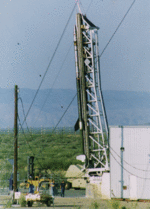
"To measure the spectrum of the diffuse X-ray emission from the interstellar medium over the energy range 0.07 to 1 keV, NASA launched a Black Brant 9 from White Sands Missile Range, New Mexico on May 1, 2008.[1]"[2]
"The US Naval Research Laboratory group launched an Aerobee 150 during April, 1965 that was equipped with a pair of geiger counters.[3] This flight discovered seven candidate X-ray sources, including the first extragalactic X-ray source; designated Virgo X-1 as the first X-ray source detected in Virgo.[4] A later Aerobee rocket launched from White Sands Missile Range on July 7, 1967, yielded further evidence that the source Virgo X-1 was the radio galaxy Messier 87.[5] Subsequent X-ray observations by the HEAO 1 and Einstein Observatory showed a complex source that included the active galactic nucleus of Messier 87.[6] However, there is little central concentration of the X-ray emission.[7]"[8]
Theoretical sounding rocketry

Robert H. Goddard first "shot a scientific payload (barometer and camera) in a rocket flight (1929, Auburn, Massachusetts)".[9]
Geography
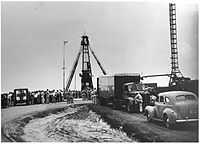

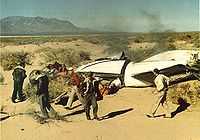

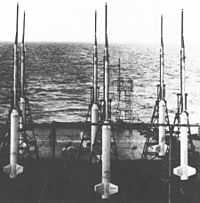
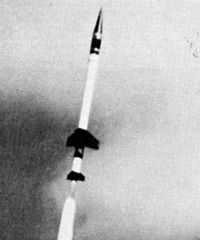
For possibly locating X-ray sources above the Earth's atmosphere, there are a number of reasons to consider probing from different geographical locations:
- early visual observations of the solar corona are associated with eclipses of the Sun by the Moon,
- if the Sun is an X-ray source, then perhaps other stars are, and only so many can be observed from one location,
- laboratory measurements use a peak of intensity to background (possible unknown sources) technique which demands measuring an X-ray background noise, and
- there may be X-ray scattering by the Earth's upper atmosphere.
Observatories on the Earth's surface do not seem like a useful place to conduct X-ray astronomy observations in view of the inability of X-rays to reach even the peaks of the highest mountains. From the earliest speculations about detecting X-rays above the Earth's atmosphere, the need to use an appropriate probe suggested a high altitude sounding rocket. The ending of World War II presented an opportunity to use a ballistic missile for just such a purpose. The White Sands Proving Grounds in New Mexico, at the time an army base, is the first location on land to test the concept. The image at the right shows the V-2 launch complex prior to the launch of V-2 number 6.
The first successful attempt to detect X-rays above the Earth's surface occurred at White Sands Proving Grounds on August 5, 1948, by lofting an X-ray detector with a V-2 rocket.
As with visual or optical astronomy observatories, there is a tendency to place them away from population centers. The photograph at right of the January 18, 1951, V-2 launch indicates one reason for doing so with X-ray observing. Rockets lofted upwards tend to return.
In the southern hemisphere at Woomera, South Australia, another X-ray observing location uses a famous and probably the most successful sounding rocket, the Skylark, to place X-ray detectors at suborbital altitudes. "[T]he first X-ray surveys of the sky in the Southern Hemisphere" are accomplished by Skylark launches.[10]
The NRL and NASA establish another rocket launching facility outside Natal, Brazil to detect X-ray sources in the southern hemisphere.[11] In addition to land-based surface launches of sounding rockets for X-ray detection, occasionally ocean surface ships served as stable platforms. The USS Point Defiance (LSD-31) is one of the first rocket-launching surface ships to support the 1958 IGY Solar Eclipse Expedition to the Danger Island region of the South Pacific. Launchers on deck fired eight Nike-Asp sounding rockets. Each rocket carried an X-ray detector to record X-ray emission from the Sun during the solar eclipse on October 12, 1958.
History
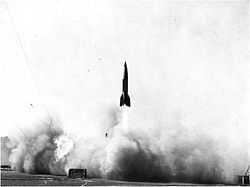
| |
Subject classification: this is a history resource . |
In 1927, E.O. Hulburt of the US Naval Research Laboratory (NRL) and associates Gregory Breit and Merle Tuve of the Carnegie Institution of Washington considered the possibility of equipping Robert H. Goddard's rockets to explore the upper atmosphere.[12] "Two years later, he proposed an experimental program in which a rocket might be instrumented to explore the upper atmosphere, including detection of ultraviolet radiation and X-rays at high altitudes."[12]
The beginning of the search for X-ray sources above the Earth's atmosphere is August 5, 1948, at 12:07 GMT (Greenwich Mean Time).[13][14] As part of Project Hermes a US Army (formerly German) V-2 rocket number 43 is launched from White Sands Proving Grounds, launch complex (LC) 33, to an altitude of 166 km.[14] This is "the first detection of solar X-rays."[10] After detecting X-ray photons from the Sun in the course of the rocket flight, T.R. Burnight wrote, “The sun is assumed to be the source of this radiation although radiation of wave-length shorter than 4 angstroms would not be expected from theoretical estimates of black body radiation from the solar corona.”[15]
Research
Hypothesis:
- Sounding rockets provide a relatively inexpensive way to test new detector technology.
Control groups

The findings demonstrate a statistically systematic change from the status quo or the control group.
“In the design of experiments, treatments [or special properties or characteristics] are applied to [or observed in] experimental units in the treatment group(s).[16] In comparative experiments, members of the complementary group, the control group, receive either no treatment or a standard treatment.[17]"[18]
Proof of concept
Def. a “short and/or incomplete realization of a certain method or idea to demonstrate its feasibility"[19] is called a proof of concept.
Def. evidence that demonstrates that a concept is possible is called proof of concept.
The proof-of-concept structure consists of
- background,
- procedures,
- findings, and
- interpretation.[20]
Proof of technology
"[T]he objective of a proof of technology is to determine the solution to some technical problem, such as how two systems might be integrated or that a certain throughput can be achieved with a given configuration."[21]
Def.
- "[a]n original object or form which is a basis for other objects, forms, or for its models and generalizations",[22]
- "[a]n early sample or model built to test a concept or process",[22] or
- "[a]n instance of a category or a concept that combines its most representative attributes"[22] is called a prototype.
Def. "[t]o test something using the conditions that it was designed to operate under, especially out in the real world instead of in a laboratory or workshop"[23] is called "field-test", or a field test.
A "proof-of-technology prototype ... typically implements one critical scenario to exercise or stress the highest-priority requirements."[24]
"[A] proof-of-technology test demonstrates the system can be used"[25].
"The strongest proof of technology performance is based on consistency among multiple lines of evidence, all pointing to similar levels of risk reduction."[26]
See also
References
- ↑ B. Wright. "36.223 UH MCCAMMON/UNIVERSITY OF WISCONSIN".
- ↑ Marshallsumter (April 15, 2013). "X-ray astronomy, In: Wikipedia". San Francisco, California: Wikimedia Foundation, Inc. Retrieved 2013-05-11.
- ↑ Stephen A. Drake. "A Brief History of High-Energy Astronomy: 1965 - 1969". NASA HEASARC. Retrieved 2011-10-28.
- ↑ Charles, P. A.; Seward, F. D. (1995). Exploring the X-ray universe. Cambridge, England: Press Syndicate of the University of Cambridge. p. 9. ISBN 0-521-43712-1.
- ↑ Bradt, H.; Naranan, S.; Rappaport, S.; Spada, G. (June 1968). "Celestial Positions of X-Ray Sources in Sagittarius". The Astrophysical Journal 152 (6): 1005–13. doi:10.1086/149613.
- ↑ Lea, S. M.; Mushotzky, R.; Holt, S. S. (November 1982). "Einstein Observatory solid state spectrometer observations of M87 and the Virgo cluster". The Astrophysical Journal 262: 24–32. doi:10.1086/160392.
- ↑ B. D.Turland (February 1975). "Observations of M87 at 5 GHz with the 5-km telescope". Monthly Notices of the Royal Astronomical Society 170: 281–94.
- ↑ RJHall (April 21, 2013). "Messier 87, In: Wikipedia". San Francisco, California: Wikimedia Foundation, Inc. Retrieved 2013-05-12.
- ↑ Mary Bellis (July 7, 2014). "Invention and History of Rockets Robert Goddard (1882-1945)". About.com. Retrieved 2014-07-07.
- 1 2 Ken Pounds (September 2002). "Forty years on from Aerobee 150: a personal perspective". Philosophical Transactions of the Royal Society London A 360 (1798): 1905-21. doi:10.1098/rsta.2002.1044. PMID 12804236. http://rsta.royalsocietypublishing.org/content/360/1798/1905.long. Retrieved 2011-10-19.
- ↑ William R. Corliss (1971). NASA Sounding Rockets, 1958-1968 A Historical Summary NASA SP-4401. Washington, DC: NASA. pp. 158. http://history.nasa.gov/SP-4401/sp4401.htm. Retrieved 2011-10-19.
- 1 2 Bruce Hevly (1994). Gregory Good. ed. Building a Washington Network for Atmospheric Research, In: The Earth, the Heavens, and the Carnegie Institution of Washington. Washington, DC: American Geophysical Union. pp. 143-8. ISBN 0-87590-279-0. http://books.google.com/books?hl=en&lr=&id=YTvlaU_Ot6AC&oi=fnd&pg=PA143&ots=OnxgivuQeK&sig=aWoylkajjpSpi8ZDFdCT3G2OnVI. Retrieved 2011-10-16.
- ↑ Rolf Mewe (December 1996). "X-ray Spectroscopy of Stellar Coronae: History - Present - Future". Solar Physics 169 (2): 335-48. doi:10.1007/BF00190610.
- 1 2 T. R. Burnight (1949). "Soft X-radiation in the upper atmosphere". Physical Review A 76: 165.
- ↑ Manuel Güdel (2004). "X-ray astronomy of stellar coronae". Astron Astrophys Rev 12 (2-3): 71-237. doi:10.1007/s00159-004-0023-2.
- ↑ Klaus Hinkelmann, Oscar Kempthorne (2008). Design and Analysis of Experiments, Volume I: Introduction to Experimental Design (2nd ed.). Wiley. ISBN 978-0-471-72756-9. http://books.google.com/?id=T3wWj2kVYZgC&printsec=frontcover.
- ↑ R. A. Bailey (2008). Design of comparative experiments. Cambridge University Press. ISBN 978-0-521-68357-9. http://www.cambridge.org/uk/catalogue/catalogue.asp?isbn=9780521683579.
- ↑ "Treatment and control groups, In: Wikipedia". San Francisco, California: Wikimedia Foundation, Inc. May 18, 2012. Retrieved 2012-05-31.
- ↑ "proof of concept, In: Wiktionary". San Francisco, California: Wikimedia Foundation, Inc. November 10, 2012. Retrieved 2013-01-13.
- ↑ Ginger Lehrman and Ian B Hogue, Sarah Palmer, Cheryl Jennings, Celsa A Spina, Ann Wiegand, Alan L Landay, Robert W Coombs, Douglas D Richman, John W Mellors, John M Coffin, Ronald J Bosch, David M Margolis (August 13, 2005). "Depletion of latent HIV-1 infection in vivo: a proof-of-concept study". Lancet 366 (9485): 549-55. doi:10.1016/S0140-6736(05)67098-5. http://www.ncbi.nlm.nih.gov/pmc/articles/PMC1894952/. Retrieved 2012-05-09.
- ↑ "Proof of concept, In: Wikipedia". San Francisco, California: Wikimedia Foundation, Inc. December 27, 2012. Retrieved 2013-01-13.
- 1 2 3 "prototype, In: Wiktionary". San Francisco, California: Wikimedia Foundation, Inc. December 8, 2013. Retrieved 2014-01-03.
- ↑ "field-test, In: Wiktionary". San Francisco, California: Wikimedia Foundation, Inc. August 5, 2012. Retrieved 2013-01-13.
- ↑ A. Liu; I. Gorton (March/April 2003). "Accelerating COTS middleware acquisition: the i-Mate process". Software, IEEE 20 (2): 72-9. doi:10.1109/MS.2003.1184171. http://cin.ufpe.br/~redis/intranet/bibliography/middleware/liu-cots03.pdf. Retrieved 2012-02-15.
- ↑ Rhea Wessel (January 25, 2008). "Cargo-Tracking System Combines RFID, Sensors, GSM and Satellite". RFID Journal: 1-2. http://www.rfidjournal.com/article/pdf/3870/1/1/rfidjournal-article3870.PDF. Retrieved 2012-02-15.
- ↑ P. Suresh, C. Rao, M.D. Annable and J.W. Jawitz (August 2000). E. Timothy Oppelt. ed. [http://www.afcee.af.mil/shared/media/document/AFD-071003-081.pdf#page=108 In Situ Flushing for Enhanced NAPL Site Remediation: Metrics for Performance Assessment, In: Abiotic In Situ Technologies for Groundwater Remediation Conference]. Cincinnati, Ohio: U.S. Environmental Protection Agency. pp. 105. http://www.afcee.af.mil/shared/media/document/AFD-071003-081.pdf#page=108. Retrieved 2012-02-15.
External links
- African Journals Online
- Bing Advanced search
- Google Books
- Google scholar Advanced Scholar Search
- International Astronomical Union
- JSTOR
- Lycos search
- NASA/IPAC Extragalactic Database - NED
- NASA's National Space Science Data Center
- Office of Scientific & Technical Information
- Questia - The Online Library of Books and Journals
- SAGE journals online
- The SAO/NASA Astrophysics Data System
- Scirus for scientific information only advanced search
- SDSS Quick Look tool: SkyServer
- SIMBAD Astronomical Database
- SIMBAD Web interface, Harvard alternate
- Spacecraft Query at NASA.
- SpringerLink
- Taylor & Francis Online
- Universal coordinate converter
- Wiley Online Library Advanced Search
- Yahoo Advanced Web Search
| ||||||||||||||||||||||||||||||||||||||
| |||||||||||||||||||||||||||||||||||||||||
![]() This is a research project at http://en.wikiversity.org
This is a research project at http://en.wikiversity.org
| |
Educational level: this is a research resource. |
| |
Resource type: this resource is an article. |
| |
Resource type: this resource contains a lecture or lecture notes. |
| |
Subject classification: this is an astrophysics resource. |
| |
Subject classification: this is a technology resource . |